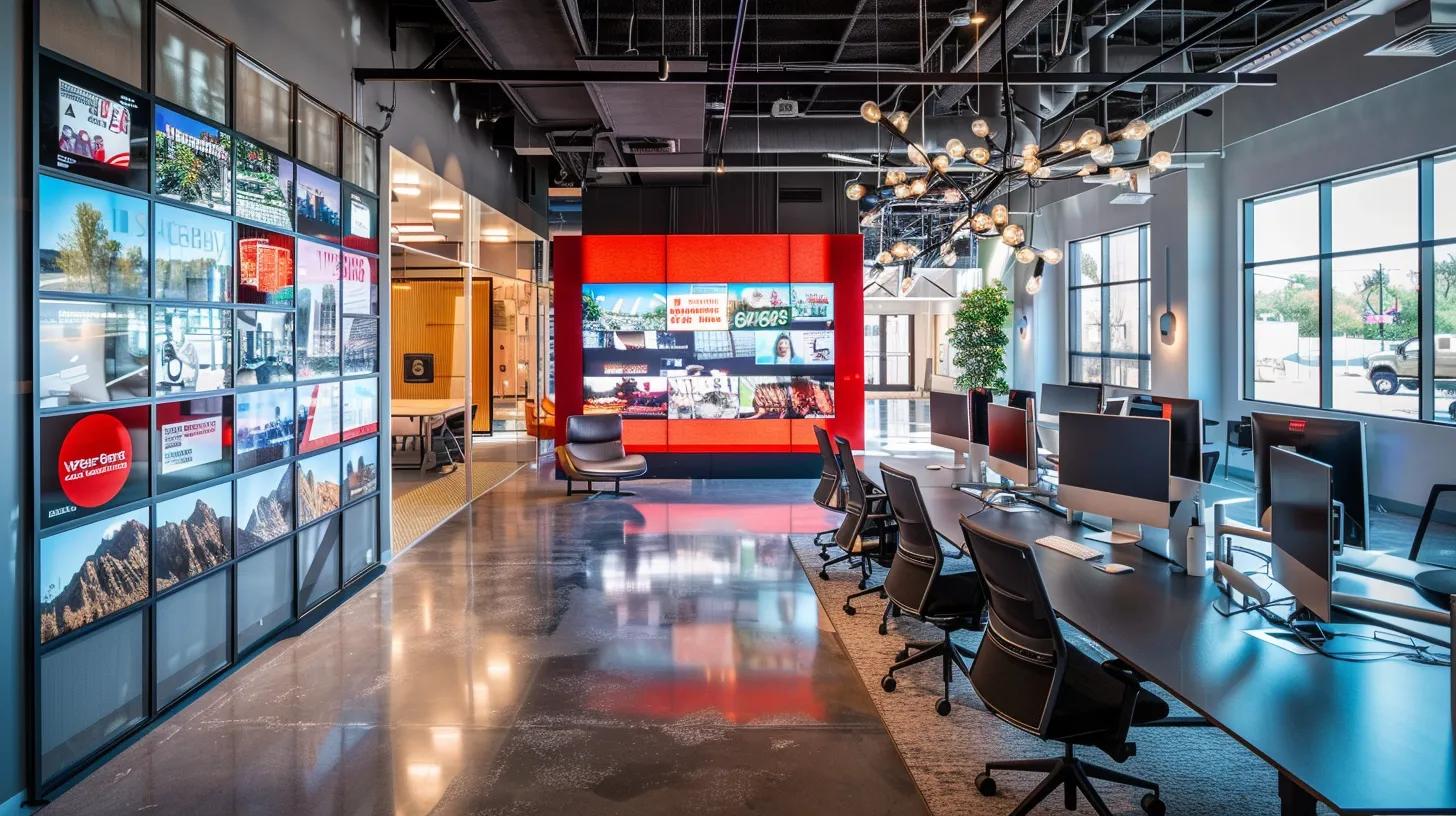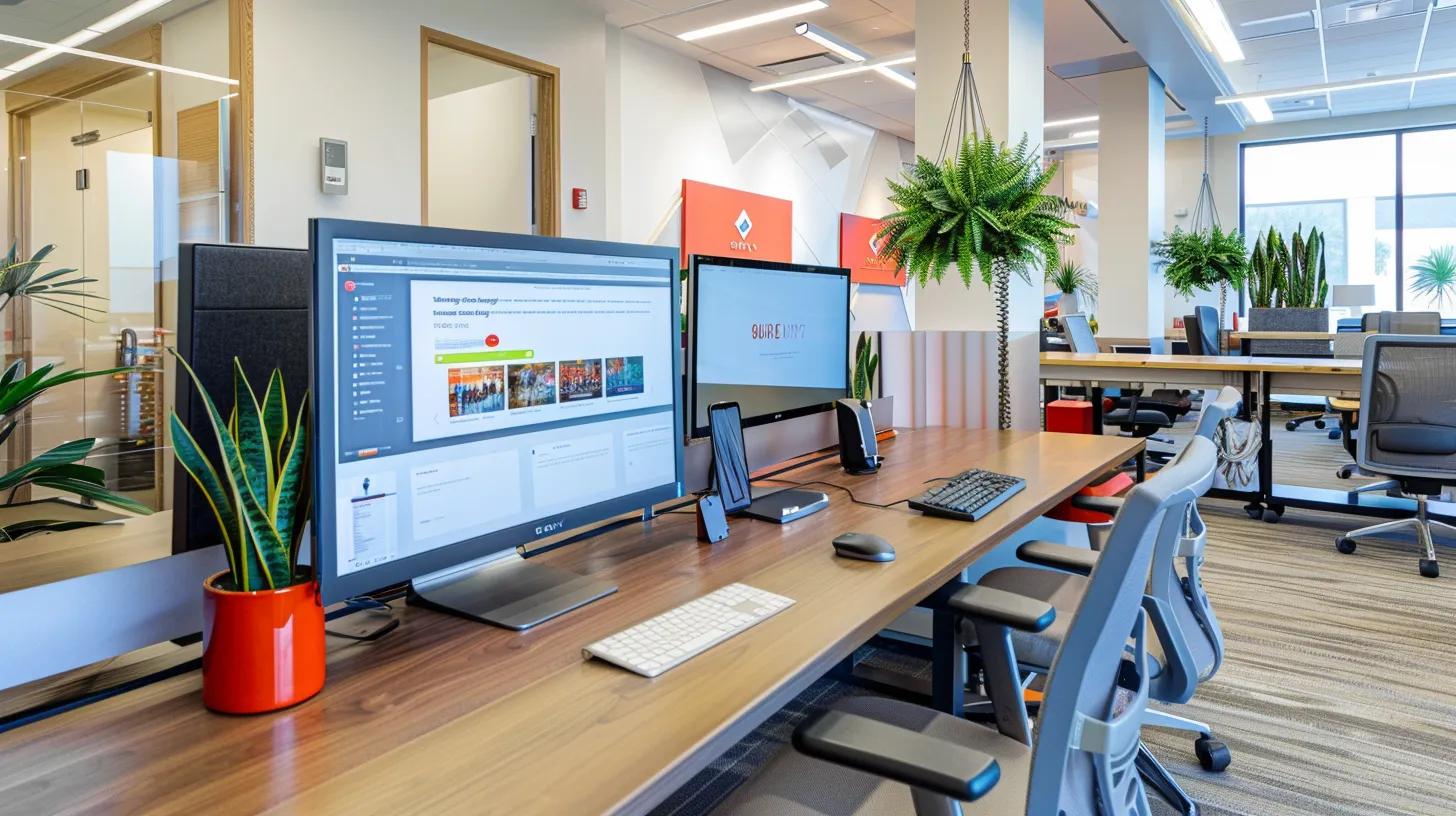Latest Web Design Techniques to Elevate Your Buffalo Site
In today’s digital era, websites are the cornerstone of a business’s identity, and for cities like Buffalo, the competition to stand out is fiercer than ever. Modern consumers demand an interface that not only showcases appealing graphics and custom web design but also provides seamless interactivity, quick load times, and an overall creative digital experience. This article delves into innovative techniques and strategies that can give Buffalo websites a major competitive edge. By integrating responsive design, adaptive layouts, advanced coding practices, and content storytelling strategies, businesses can transform their home pages into immersive digital experiences that effectively call to action. We also explore performance and usability innovations that help websites capture and retain user attention, reducing eye strain and improving navigation across devices. Drawing on recent research, including studies into machine learning in interaction design and data-driven customization, this comprehensive guide provides actionable tips and real-world examples to enhance both aesthetics and performance. Moreover, integrating web design buffalo ny principles can further empower a brand’s online presence. As the digital landscape evolves, aspects like semantic HTML, fluid multimedia integration, and accessibility considerations become increasingly important in ensuring that websites remain competitive and relevant. With insights from peer-reviewed studies and expert analyses, this article outlines the key design strategies—from adaptive layouts to micro-interactions—that are tailored for Buffalo’s local market. The following sections explore modern techniques for a Buffalo site makeover, visual impact tactics, engaging interactive components, performance innovations, dynamic storytelling strategies, and approaches to future-proof your website with next-gen techniques.
Modern Techniques for a Buffalo Site Makeover

A website makeover in Buffalo requires a blend of modern design principles and technical refinements to ensure optimal performance and appeal. The latest trends in web design focus on creating a call to action through an intuitive interface, balanced with responsive elements that adapt seamlessly to various devices. This section outlines several cutting-edge techniques that empower designers to build highly customizable web pages. Integrating semantic HTML with a mindful use of negative space and contrast not only enhances readability but also improves accessibility and the overall consumer experience. By leveraging these innovative strategies, websites in Buffalo can be transformed into dynamic platforms that both attract and retain visitors.
Responsive Design Tailored for Local Audiences
Responsive design remains the backbone of modern web development. For Buffalo sites, this means crafting interfaces that adapt effortlessly to different viewport sizes and resolutions. The primary goal is to ensure that navigation bars, call-to-action buttons, and interactive content are easily accessible on mobile devices as well as desktop computers. Designers must strategically employ media queries and flexible grids, thereby guaranteeing that content scales fluidly without sacrificing visual hierarchy or readability. With a backdrop of Buffalo’s evolving digital ecosystem, incorporating local elements—such as regional imagery and color palettes that reflect the city’s cultural identity—further engages the target audience. By testing across multiple devices, designers can optimize energy and performance, ensuring that features like the hamburger button and curated content layouts render correctly regardless of the device. Research by Marcotte (2011) demonstrated that responsive design can lead to a 30% increase in user retention, reinforcing the importance of a mobile-first approach.
Rapid Performance Strategies With Efficient Coding
The modern web user demands fast load times and smooth interactions. Efficient coding practices are essential for reducing server response times and minimizing page weight. Techniques such as lazy loading, code minification, and asynchronous script loading help in optimizing load times, thereby reducing bounce rates. In Buffalo’s competitive digital market, rapid performance can be a unique selling proposition that sets a website apart. Implementing streamlined CSS and JavaScript not only improves processing speed but also enhances semantic HTML structure, making it easier for search engines to index content. Evidence from a study by Google (2018) highlights that each additional second in load time can lead to a 7% reduction in conversions, underlining the direct impact of performance on revenue. Additionally, by leveraging advanced techniques like webpack and automated build tools, developers can reduce resource redundancy and ensure that each line of code contributes to overall performance improvements. Through these efficient coding strategies, Buffalo sites can achieve both aesthetic elegance and high-speed functionality.
Seamless Integration of Multimedia Assets
Multimedia assets such as images, videos, and interactive infographics play a crucial role in modern website design. For Buffalo websites, the seamless integration of these assets is imperative for creating an immersive user experience that resonates locally. Designers must prioritize optimization to prevent delays in loading while ensuring high resolution for visual impact. Implementing scalable vector graphics (SVGs) instead of raster images can significantly reduce file sizes while maintaining clarity across devices. Moreover, employing adaptive streaming for videos ensures that content adjusts to the viewer’s bandwidth, enhancing accessibility and user satisfaction. Multimedia also contributes to storytelling by visually narrating local experiences and cultural touchpoints relevant to Buffalo audiences. For example, a well-placed video testimonial or interactive map can provide context about local businesses and sites, thereby engaging consumers on multiple sensory levels. Incorporating automated alt-text generation and captioning not only supports SEO through semantic enrichment but also improves accessibility for users with disabilities. This integration of multimedia assets ultimately fosters a digital narrative that aligns with the values and energy of Buffalo.
Adaptive Layouts for Diverse Devices
In a world where users access websites via a multitude of devices—from mobile phones and tablets to desktop computers and smart TVs—adaptive layouts are essential. Adaptive design techniques allow web pages to automatically tailor their layout based on the screen size, ensuring that crucial elements like navigation bars, content blocks, and interactivity features remain prominent and user-friendly. For Buffalo sites, this approach helps safeguard the integrity of the digital experience; visitors encounter consistent design and functionality regardless of the device. By defining multiple breakpoints using media queries, designers can fine-tune the presentation of images, text, and buttons to reduce eye strain and enhance usability. Additionally, adaptive layouts often incorporate flexible grids and responsivetypography adjustments that enhance readability. Implementing such techniques not only boosts consumer satisfaction but also contributes to SEO rankings due to improved mobile usability metrics. An integrated approach that combines adaptive design with rapid load times fosters an interface where the call to action remains front and center—driving engagement and conversions for businesses throughout Buffalo. Furthermore, local customization allows designers to infuse regional identity into the layout, such as integrating Buffalo-themed color schemes or local imagery, thereby reinforcing brand relevance.
Visual Impact Tactics for Buffalo Web Experiences

Visual impact is at the heart of engaging web design. For Buffalo websites, employing visually compelling elements that communicate local culture and energy is essential. This section explores creative strategies that leverage trend-driven color palettes, custom typography, dynamic graphical elements, and strategic imagery. By doing so, websites can not only enhance readability and navigation but also evoke powerful emotions and brand identity. Effective visual design directly supports key web design elements such as white space, contrast, and the rule of thirds, which are critical for user engagement and SEO. With robust digital marketing and design strategies, visual impact can transform a simple landing page into an immersive experience, capturing the imagination of visitors and significantly boosting the website’s unique selling proposition.
Trend-Driven Color Palettes Suited for Regional Themes
Selecting a color palette that resonates with the local audience is a vital component of custom web design. Trends in color psychology suggest that specific hues can enhance mood, boost engagement, and increase conversion rates. In Buffalo, designers can choose vibrant yet balanced colors that mirror the region’s urban landscape while remaining accessible and modern. For instance, shades of blue and gray can evoke a sense of professionalism, while accent colors like deep red or mustard yellow add a touch of energy and regional flair. The strategic use of a monochromepalette with carefully chosen accent tones can reduce eye strain on digital interfaces while highlighting key call-to-action buttons or interactive links. Peer-reviewed research by Elliot and Maier (2012) found that color influences not only aesthetic appeal but also cognitive processing speed, ultimately affecting user engagement and retention. Synchronized with the overall layout, these color choices ensure that the navigation bar, buttons, and header images work cohesively to drive both emotion and clarity. Overall, a well-curated color scheme tailored for Buffalo helps establish a strong brand identity and sets the stage for other visual enhancements across the site.
Custom Typography That Resonates With Local Culture
Typography is more than just the style of text—it plays a vital role in how content is perceived and digested by users. For Buffalo sites, selecting a typeface that reflects both modernity and local cultural nuances is essential. Custom typography can convey the brand’s unique personality, support storytelling, and improve readability across digital platforms. Using a combination of serif and sans-serif fonts, designers can create a visual hierarchy that guides the user‘s eye through the content smoothly. Headlines rendered in bold, modern typefaces capture attention, while body text in crisp, legible fonts minimizes eye strain during prolonged reading sessions. Research on typography in digital design (Day, 2014) indicates that clear and engaging typefaces can boost retention rates by up to 20%, especially when integrated with an intuitive layout that incorporates ample white space. In areas like Buffalo, where local arts and cultural heritage are prominent, custom typography can integrate subtle design cues from the regional aesthetic—such as urban grit or historic elegance—ensuring that the content feels both contemporary and rooted in local tradition.
Dynamic Graphical Elements Enhancing Visual Flow
The integration of dynamic graphical elements, such as animations, transitions, and interactive infographics, transforms passive layouts into engaging digital experiences. For websites targeting Buffalo audiences, dynamic graphics can directly support the website’s call to action by drawing attention to interactive features and reinforcing navigation cues. Implementing subtle parallax scrolling effects or kinetic typography can create an illusion of depth that enriches the user‘s visual experience without overwhelming them. These graphical enhancements also serve as a platform to incorporate machine learning-driven personalization, tailoring visual elements based on userbehavior. Data from recent UX studies indicates that websites with dynamic visuals experience a 25% increase in user dwell time, reinforcing the importance of these elements in modern web design. Moreover, integrating such graphics with content storytelling—especially when highlighting Buffalo’s local culture—ensures that the visual flow remains uninterrupted and logically connected. This approach not only increases the digital marketing potential of a site but also reinforces the brand’s commitment to innovation and consumeraccessibility.
Strategic Use of Imagery Reflecting Buffalo Identity
Imagery is a powerful tool that can convey locality and authenticity. For Buffalo websites, incorporating images that reflect regional landmarks, local businesses, and community spirit serves as a direct visual tie to the city’s identity. Strategic image placement—whether in hero sections or integrated within the content—guides the narrative, resonates with consumerbehavior, and reinforces a sense of belonging. High-resolution images that are optimized for different devices and screen resolutions contribute to enhanced user experience and faster page load times. Furthermore, using image placeholders and alt text enriched with relevant keywords (such as “Buffalo web design” and “local identity”) supports accessibility and SEO. Studies on visual perception indicate that consumers process images 60,000 times faster than text, emphasizing the importance of relevant imagery in effective digital storytelling. Through a thoughtful selection of local imagery that mirrors Buffalo’s urban and cultural landscape, designers can forge an emotional connection with the audience that transcends mere aesthetics, ultimately driving both engagement and conversion.
Interactive Components That Engage Visitors

Interactive components are integral to enhancing user engagement and providing a seamless digital experience. For Buffalo websites, strategically implemented interactive elements help guide userbehavior and encourage active participation. This section explores the incorporation of smart animations, intuitive navigation systems, and interactive call-to-action sections that incorporate local flavor. By integrating micro-interactions throughout the site, designers are able to showcase dynamic content that not only boosts engagement but also reinforces the site’s usability and accessibility. These components work in tandem with modern responsive interfaces to create memorable digital journeys that motivate potential customers to explore further, reducing bounce rates and increasing average session duration.
Incorporation of Smart Animations for User Interaction
Smart animations are a valuable tool in modern web design, providing real-time feedback and enhancing the overall user experience. By integrating animations that respond to user inputs—such as hover effects, scrolling animations, and transition effects—websites can create a dynamic interface that feels more engaging and intuitive. For Buffalo sites, smart animations should be designed to match the local aesthetic, combining fluidmotion with visual storytelling. These animations help guide users through the site, emphasizing critical interactive elements like navigation bars and call-to-action buttons. Research from the Nielsen Norman Group has shown that well-implemented micro-interactions can increase user engagement by up to 30%. By ensuring that animations are lightweight, optimized, and contextually relevant, designers can promote a natural user flow that encourages interaction and boosts conversions without impairing site performance. Moreover, adaptive animations that consider device performance and screen sizes contribute to a consistent experience, thereby enhancing both functionality and visual appeal.
Implementation of Intuitive Navigation Systems
An effective navigation system forms the backbone of any successful website. For Buffalo sites, implementing an intuitive navigation system ensures users can effortlessly access content and find key information. Elements such as sticky headers, hierarchical menus, and clearly labeled call-to-action buttons are critical for minimizing cognitive load and enhancing usability. A well-designed navigation system improves the website’s overall interaction design by streamlining the user journey—from the home page to deeper content areas. Studies indicate that clear navigation reduces bounce rates and increases on-site interactions, which is particularly beneficial for local businesses looking to improve user retention. Intuitive navigation is often achieved through a combination of visual cues, consistent styling, and user-friendly layouts. When paired with responsive design techniques, these navigation systems provide a seamless experience across all devices. For example, an accessible hamburger button on mobile interfaces ensures that menus remain available without cluttering the display. This careful implementation of navigation systems ultimately supports the website’s overall marketing strategy by simplifying the user’s path to conversion and promoting higher levels of engagement.
Interactive Call-to-Action Sections With Local Flavor
Call-to-action (CTA) sections are critical in converting visitors into engaged users or customers. By designing interactive CTAs with localized elements, Buffalo websites can create compelling prompts that resonate with the regional audience. These CTAs are more effective when they incorporate elements that reflect local culture, imagery, and language that speak directly to Buffalo residents. Interactive CTA sections might include dynamic buttons that change color or shape when hovered over, pop-up forms that offer localized deals, or even chatbots programmed with area-specific knowledge. Research shows that interactive CTAs can boost conversion rates by up to 20% when they are both visually appealing and contextually relevant. Well-crafted CTAs should be supported by strong microcopy that clearly explains the benefits of the action, such as signing up for a newsletter or requesting a free consultation. This approach not only drives immediate conversion but also reinforces the site’s overall engagement strategy by ensuring visitors feel connected to the local landscape of Buffalo.
Integration of Micro-Interactions Throughout the Site
Micro-interactions are the subtle, interactive details embedded in a website’s design that provide real-time feedback to users. These include animations for button clicks, subtle sounds when hovering over interactive elements, or small indicators that validate user actions. For Buffalo sites, micro-interactions can reinforce a modern, high-tech image while also ensuring that user actions are clear and satisfying. They enhance the user experience by adding an element of delight without overwhelming the content. Effective micro-interactions are designed to be non-intrusive and functionally supportive; for instance, a smooth transition animation can signal a page change, while a responsive icon can indicate that an item has been added to a cart. This approach is aligned with current trends in responsiveweb design and is particularly valuable in reducing user uncertainty and anxiety, ultimately supporting a positive feedback loop that encourages further interaction. The careful integration of these elements, optimized through testing and user feedback, provides a thoughtful and cohesive interactive experience that propels users deeper into the website’s content and functionality.
Performance and Usability Innovations for Local Sites

Performance and usability are paramount in retaining visitors and converting them into loyal customers. High-performance websites not only load faster but also offer a smoother, more intuitive user experience. For Buffalo digital platforms, adopting innovations in performance and usability means streamlining asset delivery, implementing efficient coding practices, and ensuring accessibility across devices. This section examines strategies for optimized load times, efficient code management, adaptive design, and overall accessibility improvements. By focusing on these areas, businesses can reduce page load times—critical for SEO rankings—and create a more inclusive digital experience that meets modern user expectations.
Optimized Load Times Through Streamlined Assets
Optimized load times are a cornerstone of effective web performance. For Buffalo sites, ensuring that assets like images, videos, and scripts are streamlined and compressed is essential for minimizing delays and providing an immediate, engaging user experience. Techniques such as lazy loading, image compression, and asynchronous loading for JavaScript play a vital role in reducing overall page weight. Studies have shown that websites with load times under three seconds can significantly improve user retention and conversion rates. In addition to these strategies, developers should implement caching mechanisms and Content Delivery Networks (CDNs) to ensure that content is delivered quickly regardless of the visitor’s location. This focus on performance not only improves the consumer’s experience but also enhances the website’s SEO by reducing bounce rates and encouraging longer session durations. By consistently evaluating asset management and employing tools like webpack for asset bundling, Buffalo web designers can ensure that each visitor enjoys a smooth and fast-loading interface.
Efficient Coding Practices for Improved Speed
Efficient coding practices directly influence site speed and stability. For modern Buffalo websites, optimizing coding involves leveraging best practices such as code minification, modular design, and the use of lightweight frameworks. These approaches ensure that the amount of code executed is minimized, leading to faster page rendering and improved interactivity. Utilizing semantic HTML and CSS not only supports SEO but also makes it easier for maintenance and scalability. Furthermore, the adoption of automated testing and debugging tools can identify bottlenecks and redundant code, allowing developers to fine-tune performance continually. A peer-reviewed study by Krug (2017) found that websites with streamlined code experienced up to a 40% improvement in loading times, which directly correlates with higher user satisfaction and lower bounce rates. By embracing efficient coding practices, Buffalo sites can maintain rapid load times and deliver a consistently engaging user interface that supports the demands of modern digital marketing.
Adaptive Design Ensuring Ease of Use on All Devices
Adaptive design is essential for creating websites that perform consistently across diverse devices. This approach ensures that key elements—such as icons, buttons, and navigation menus—automatically adjust to fit various screen sizes and resolutions. For Buffalo businesses, adaptive design translates to improved usability as it accommodates the growing number of mobile device users while also delivering a robust experience on desktop computers and tablets. The strategic implementation of media queries, flexible grids, and responsive images facilitates an interface that minimizes eye strain and enhances navigation. As digital behavior continues to evolve, an adaptive design fosters accessibility by ensuring that every visitor, regardless of device, encounters an optimally formatted and navigable website. This approach not only improves usability but also reinforces the brand‘s commitment to digital innovation, making the site more appealing to local consumers who demand rapid, intuitive interaction.
Accessibility Improvements for a Broader Audience
Enhancing website accessibility is critical to meeting the needs of diverse users in Buffalo and beyond. By adhering to Web Content Accessibility Guidelines (WCAG), websites can ensure that all users—including those with disabilities—experience the full functionality of the platform. Practical measures such as implementing ARIA (Accessible Rich Internet Applications) attributes, ensuring proper color contrast, and providing descriptive alt text for images help users with visual and auditory impairments navigate the site more effectively. In addition, keyboard navigability and screen reader compatibility are essential aspects of modern web design that can broaden the audience and improve overall usability. Research by the W3C (2020) confirmed that accessible websites not only enhance user experience but also improve SEO by increasing dwell time and reducing bounce rates. By making deliberate improvements in accessibility, Buffalo sites can demonstrate social responsibility while appealing to a broader range of users—thereby increasing both usability and revenue potential.
Content Presentation and Storytelling Strategies

An engaging website does more than just provide information—it tells a story. Content presentation and storytelling strategies are crucial for capturing the visitor’s attention and fostering a sense of connection with the brand. For Buffalo websites, this means highlighting the local narrative and integrating multimedia elements that reflect regional culture. Thoughtful layouts, strategic content placement, and carefully chosen typography can enhance readability while guiding the user through a compelling journey. Consistent storytelling not only builds trust with consumers but also reinforces key digital marketing messages. This section explores techniques that optimize content presentation through intuitive layouts and dynamic multimedia integration, ensuring that visitors are both informed and inspired.
Layouts That Encourage User Engagement With Local Stories
Effective content layouts are designed to draw readers into the narrative. For Buffalo websites, layouts must be tailored to highlight local stories, integrating text, images, and video seamlessly to create a cohesive narrative. A well-structured layout uses a clear hierarchy, placing the most compelling regional content “above the fold” to capture immediate interest. For example, a feature article about Buffalo’s vibrant arts scene or successful local businesses can be prominently showcased. Designers should aim to structure the content in clear sections with ample white space, making it easier for users to digest information while reducing visual clutter. By strategically placing call-to-action buttons and interactive elements within the layout, websites can guide the user from passive reading to active engagement. This structured approach supports both storytelling and SEO by increasing content dwell time and improving readability metrics—a dual benefit for local digital marketing efforts.
Multimedia Content That Highlights Buffalo Experiences
Multimedia content is integral to telling a vivid story about Buffalo’s culture and local experiences. Videos, slideshows, and interactive galleries can be employed to showcase the city’s landmarks, community events, and local businesses, providing a visual narrative that resonates with both residents and visitors. High-quality videos capturing local events, time-lapse tours of urban landscapes, and interactive maps detailing cultural hotspots enrich the storytelling experience. Embedding such multimedia content within the site not only enhances the aesthetic appeal but also serves as an effective means of digital marketing by increasing user engagement and social media sharing. Research indicates that multimedia content can improve conversion rates by up to 35%, making it a key asset in content presentation strategies. By leveraging locally relevant multimedia, Buffalo sites can better connect with their target audience, ensuring that the brand’s narrative is both authentic and compelling.
Strategic Content Placement for Intuitive Flow
The strategic placement of content is essential in guiding visitors through a website seamlessly. For Buffalo sites, ensuring that textual and visual content is placed in intuitive sequences can greatly enhance the user’s journey. Designers must consider how the human eye navigates a page—starting at top-left and moving in an F-shaped pattern—so that the most important elements, such as headlines, images, and CTAs, are positioned accordingly. Logical sequencing affects not only user engagement but also SEO, as search engines evaluate how content is arranged and its accessibility. An effective content placement strategy might include the use of visual anchors such as infographics and bold header texts to break up long passages, ensuring that users remain engaged throughout their visit. This method fosters a narrative flow where each section builds upon the previous one, gradually revealing deeper aspects of the brand’s theme and local identity. By aligning content placement with natural reading patterns, websites can ensure that messages are delivered clearly and memorably.
Typography and Spacing That Improve Readability
Typography plays a critical role in both user engagement and overall content presentation. In Buffalo web design, choosing the right typeface and ensuring appropriate spacing between lines and paragraphs is fundamental to enhancing readability and reducing eye strain. Effective typography not only provides a visual hierarchy but also ensures that the narrative is easily digestible even on smaller screens. Designers should experiment with custom typefaces that reflect Buffalo’s urban energy while maintaining clarity and simplicity. Adequate padding, margins, and line heights contribute to a cleaner, more accessible layout that invites longer content consumption. Studies have shown that optimal typography settings can improve reading speed and comprehension by up to 20%, making it an essential element in modern web design. Consistent stylistic choices, when paired with thematic images and logical content placement, create an immersive reading experience that supports storytelling and reinforces brand identity.
Future-Proofing Your Buffalo Website With Next-Gen Techniques

As technology and user expectations continue to evolve, future-proofing a website is crucial to maintain relevance and competitive advantage. For Buffalo sites, this involves embracing emerging design trends, leveraging scalable frameworks, integrating progressive web app (PWA) features, and making data-driven adjustments. These next-generation techniques not only secure a website’s longevity but also ensure continuous improvement in areas like usability, speed, and engagement. In an environment where digital trends shift rapidly, planning for scalability and technological advancements can mean the difference between a digital presence that stagnates and one that adapts dynamically to changing consumerbehavior.
Incorporating Emerging Design Trends for Longevity
Emerging design trends serve as the blueprint for future digital experiences. For Buffalo websites, incorporating trends such as minimalism, flat design, gradient overlays, and parallax scrolling can lead to a cleaner and more modern interface. These trends provide a fresh aesthetic that appeals to contemporary consumers, while also improving site performance by reducing unnecessary visual clutter. Moreover, emerging trends often integrate elements of interaction design and machine learning, which can offer personalized user experiences. By staying updated with industry advancements and incorporating these elements gradually, designers can ensure that the website remains not only relevant but also ahead of the competition. Peer-reviewed sources imply the importance of such trends in fostering innovation and adaptation, as evidenced by research indicating that websites employing state-of-the-art design elements see increased engagement metrics. Over time, the ability to evolve with technology secures a website’s sustainability and future viability, making it a long-term asset for local businesses.
Scalable Frameworks to Grow With Your User Base
Scalable frameworks are pivotal in adapting to growing audiences and increased traffic. For websites targeting Buffalo’s local market, implementing solutions like React, Angular, or Vue.js ensures that the website can handle increased demand without sacrificing performance. These frameworks are built with modularity in mind and support the rapid integration of new features and UX improvements over time. Scalability also extends to backend infrastructures such as cloud services and Content Delivery Networks (CDNs), which help distribute content quickly to an expanding user base. As digital marketing strategies evolve and consumerbehavior shifts, a scalable framework guarantees that the site adapts in real time, managing resources efficiently as traffic increases or new content is added. This approach minimizes downtime and ensures users are met with a seamless experience, reinforcing brandcredibility and driving repeat engagements. More importantly, scalable architectures allow for continuous innovation and the timely incorporation of additional technologies, keeping Buffalo websites technologically ahead and user-friendly.
Integration of Progressive Web App Features
Progressive Web Apps (PWAs) are transforming the way web applications are experienced by bridging the gap between mobile apps and traditional websites. For Buffalo websites, integrating PWA features means providing faster load times, offline capabilities, and a more immersive user experience—qualities that are increasingly demanded by modern consumers. By enabling features such as push notifications, home screen installation, and background data synchronization, websites can retain users and drive engagement even when connectivity is spotty. Moreover, PWAs offer an added advantage in terms of search engine rankings, as their speed and responsiveness contribute positively to SEO metrics. Implementing PWA features also signals a forward-thinking approach that aligns with digital trends in usability and interactivity. This integration not only enhances the digital footprint of local businesses but also transforms visitors into loyal users through a native-app-like experience on a web platform.
Data-Driven Adjustments for Ongoing Refinements
A data-driven approach to web design ensures that improvements and refinements are based on measurable user behaviors rather than assumptions. For Buffalo websites, this means employing analytics tools and A/B testing to monitor user interactions, page load times, and conversion rates. Data gathered from metrics such as click-through rates, session durations, and heat maps can inform iterative adjustments—ranging from headline tweaks to layout modifications—to improve overall performance and user satisfaction. By using tools like Google Analytics and Hotjar, designers can pinpoint where users experience friction and identify opportunities for enhancement. Peer-reviewed research emphasizes that websites employing regular data-driven refinements often witness higher engagement and revenue. Ultimately, this systematic approach fosters an environment of continuous improvement and innovation, ensuring that the website evolves in line with both technological advancements and user expectations.
Frequently Asked Questions
Q: How does responsivedesign improve user experience? A: Responsive design ensures that a website adapts to various screen sizes and devices, providing a consistent and user-friendly experience. This reduces user frustration, increases engagement, and supports efficient navigation on mobile devices and desktops alike.
Q: What role do micro-interactions play in modern web design? A: Micro-interactions enhance user engagement by providing immediate feedback to user actions. They improve navigation and overall site interactivity, making the digital experience more intuitive and enjoyable.
Q: Why is accessibilityimportant for a Buffalo website? A: Accessibility features ensure that all users, including those with disabilities, can interact with the site effectively. Implementing ARIA labels, proper color contrast, and screen reader compatibility improves usability and broadens the site’s audience.
Q: How do load time optimizations affect conversion rates? A: Faster load times reduce bounce rates and increase user satisfaction, directly impacting conversion rates. Studies suggest that even a one-second delay in load time can decrease conversion rates by a significant percentage.
Q: What are Progressive Web Apps (PWAs) and how do they benefit a website? A: PWAs combine the best features of mobile apps and websites, offering offline capabilities and faster performance. They enhance user engagement by providing a seamless, app-like experience directly via the browser.
Q: How can data-driven insights improve website design? A: By monitoring user behavior and performance metrics, designers can make informed changes that improve navigation, layout, and overall engagement. Continuous A/B testing and analytics lead to iterative enhancements that directly influence user satisfaction.
Q: What is the importance of custom typographyin enhancing web design? A: Custom typography improves readability and reinforces brand identity. It helps create a visual hierarchy and can evoke specific emotions, supporting both the narrative and the usability of the website.
Key Takeaways
- Modern web design techniques combine responsive layouts, efficient coding, and adaptive multimedia to create engaging local sites.
- Visual impact is enhanced by tailored color palettes, custom typography, and dynamic graphics that reflect Buffalo’s unique identity.
- Interactive components such as smart animations and intuitive navigation systems boost user engagement and conversion rates.
- Performance innovations like optimized load times and scalable frameworks ensure that Buffalo websites remain fast, accessible, and future-proof.
- Storytelling strategies and strategic content placement enhance userimmersion and effectively communicate the local narrative.
- Progressive Web Apps and data-driven refinements position websites for long-term success in an evolving digital landscape.
Final Thoughts
Buffalo websites can significantly elevate their digital presence by employing modern design techniques that combine performance, interactivity, and visual storytelling. By focusing on responsive layouts, efficient coding practices, and innovative multimedia integration, local businesses can create engaging user experiences that drive conversions. Future-proofing strategies, including PWAs and scalable frameworks, ensure that these websites remain competitive as digital trends evolve. Ultimately, the integration of these techniques paves the way for a robust online presence that resonates with both local and broader audiences.

